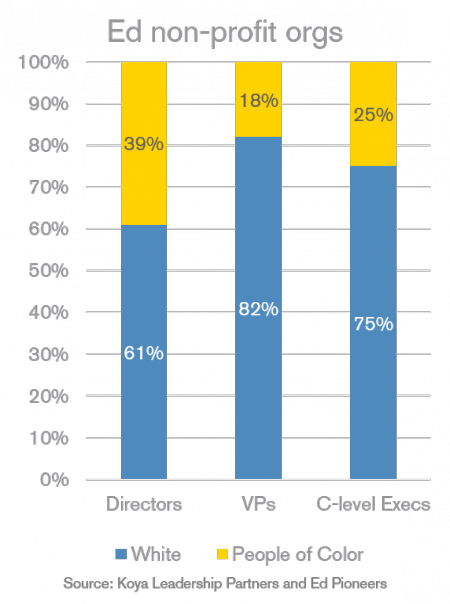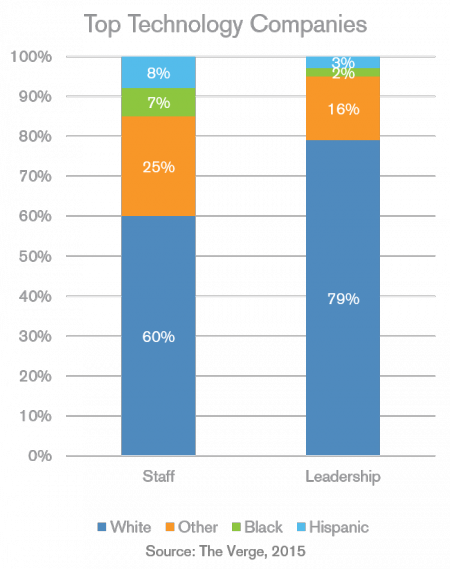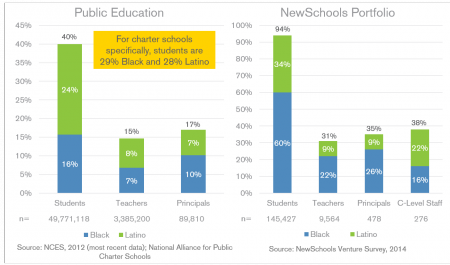Teams of educators are stepping up to create innovative schools that can prepare and inspire young people to achieve their most ambitious dreams and plans. These teams will be more successful if they understand the perspectives and needs of students and have the insight required to develop creative solutions. This means we must broaden the group of people who are generating ideas to create the innovations we need. In particular, the field needs more entrepreneurs and leaders who have shared experiences with the students they serve. Diversifying the senior leadership and boards of directors of education organizations is key to this goal. Specifically, we need to increase the percentage of Black and Latino entrepreneurs and leaders in education.
At NewSchools, we’ve publicly shared our commitment to diversifying education throughout the last year and have made investments in organizations focusing on this issue. Now we are building on our commitment by creating a dedicated investment area and focusing on our internal culture and practices.
In this blog post, we want to share the ‘why’ behind our thinking, and we’ll share a follow-up post on what we plan to do next.
Why is diversity important?
Diversifying the leadership of education organizations to better reflect the backgrounds of our students will drive greater impact for the field in three ways:
1. Increase innovation and creativity. A study by the Center of Talent Innovation found that companies with diverse leadership are 72% more likely to not fear challenging the status quo and 50% more likely to take risks, which can lead to more innovative and effective outcomes.
2. More relevant ideas. If innovators share the backgrounds of our students and understand their perspectives, the solutions they create are likely to be more relevant to student needs
3. Stronger organizations. Diverse organizations are stronger organizations because they have:
- Higher employee satisfaction with fewer conflicts between groups and improved collaboration and loyalty within organizations, according to research by McKinsey and Company
- Stronger performance, as ethnically diverse companies are 35% more likely to outperform the least diverse companies, according to the same McKinsey study
- Higher retention rates overall, and in particular for employees of color, according to a study by Common Good Careers and the Level Playing Field Institute
What is the current state of diversity across the field?
There is a strong case for why we should increase the number of Black and Latino leaders in education leadership. But when you look at statistics across the field, it is clear that we’ve got a long way to go.
Public Schools
According to the National Center for Education Statistics, approximately 40% of public school students are Black or Latino but only 15% of teachers and 17% of principals share their background. The National Alliance for Public Charter Schools show that 29% and 28% of charter school students are Black and Latino, respectively. Across the schools in the NewSchools portfolio, 94% of students are Black or Latino, while approximately one third of teachers, principals, and C-level staff share their background.
(click to see a larger version of the chart)
Education Non-Profits
According to the 2014 study by Koya Leadership Partners and Education Pioneers, education non-profits serve students that reflect the general public school student population but the staff of these organizations skew more heavily White, particularly at the senior leadership levels. According to Charter Board Partners, 90% of nonprofit boards (including education non-profits) have a White board chair and 80% of their board members are White.

The Koya study also shows that while education organizations believe that diversity is important, this commitment does not always translate into action. For example, only approximately a third of survey respondents listed diversity as a core value and have a definition of diversity, both of which are essential to delivering on a commitment to diversity.
Furthermore, foundations, a primary funding source of education non-profits, lack Black and Latino representation in leadership. In 2014, racial / ethnic minorities represented 25% of foundation staff, 32% of program officers and 8% of foundation CEOs overall according to Nonprofit Quarterly.
Education Technology
If we assume that the education technology field reflects the technology industry more broadly, the representation of Black and Latino employees is very low, especially at leadership levels. In addition, there is a lack of diversity at venture capital firms, which creates additional barriers for Black and Latino entrepreneurs to access funding. According to Tech Crunch, only 1.5% of investment team members at venture capital firms are Black.

There is a significant racial / ethnic demographic gap between the leadership of education organizations and the students they serve. We believe increased diversity in education leadership will help us achieve increased levels of innovation across our field so that all young people graduate high school prepared and inspired to achieve their most ambitious dreams and plans.
Check out our follow-up blog post with more details about our aspiration and what we plan to do to make it a reality.



